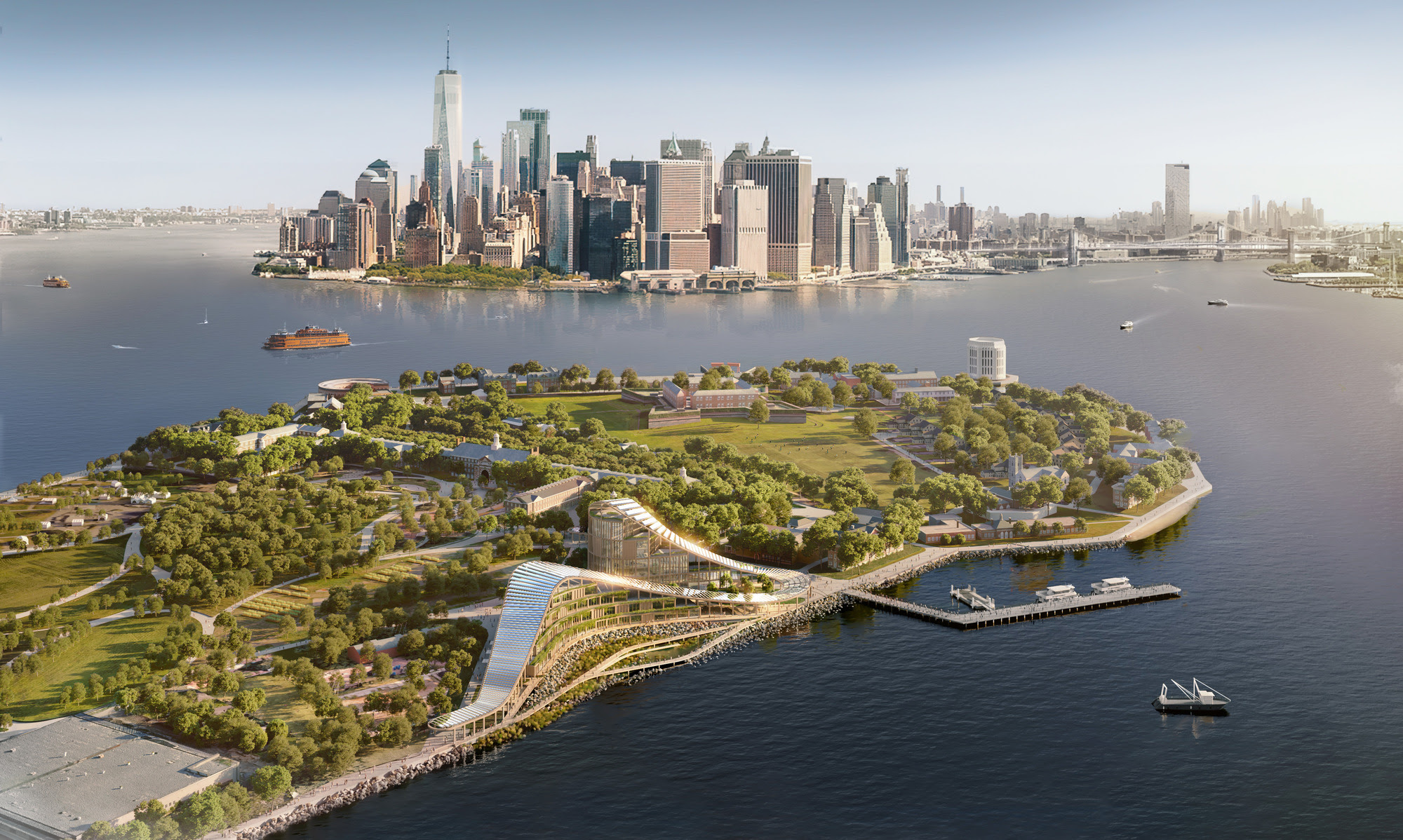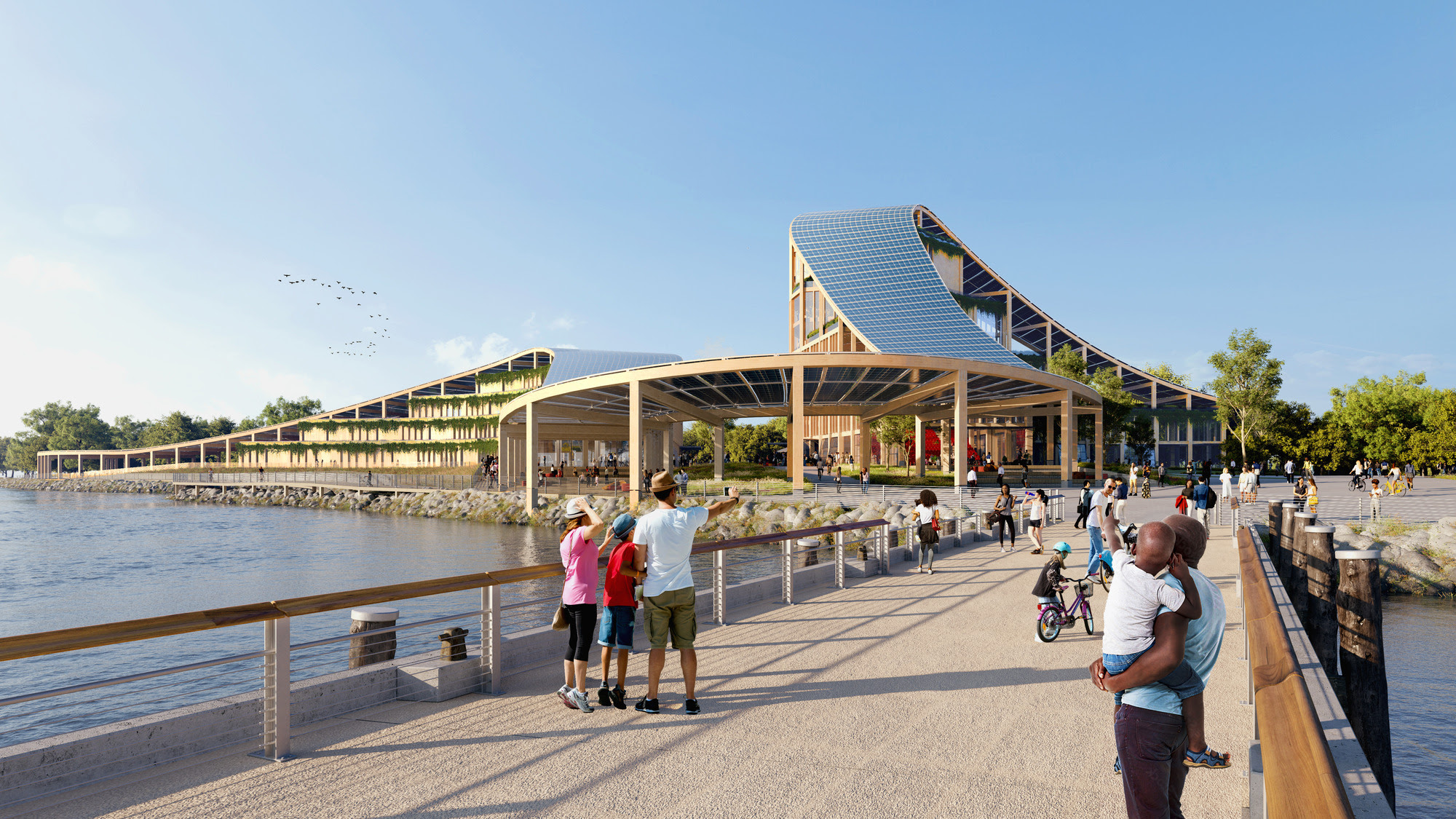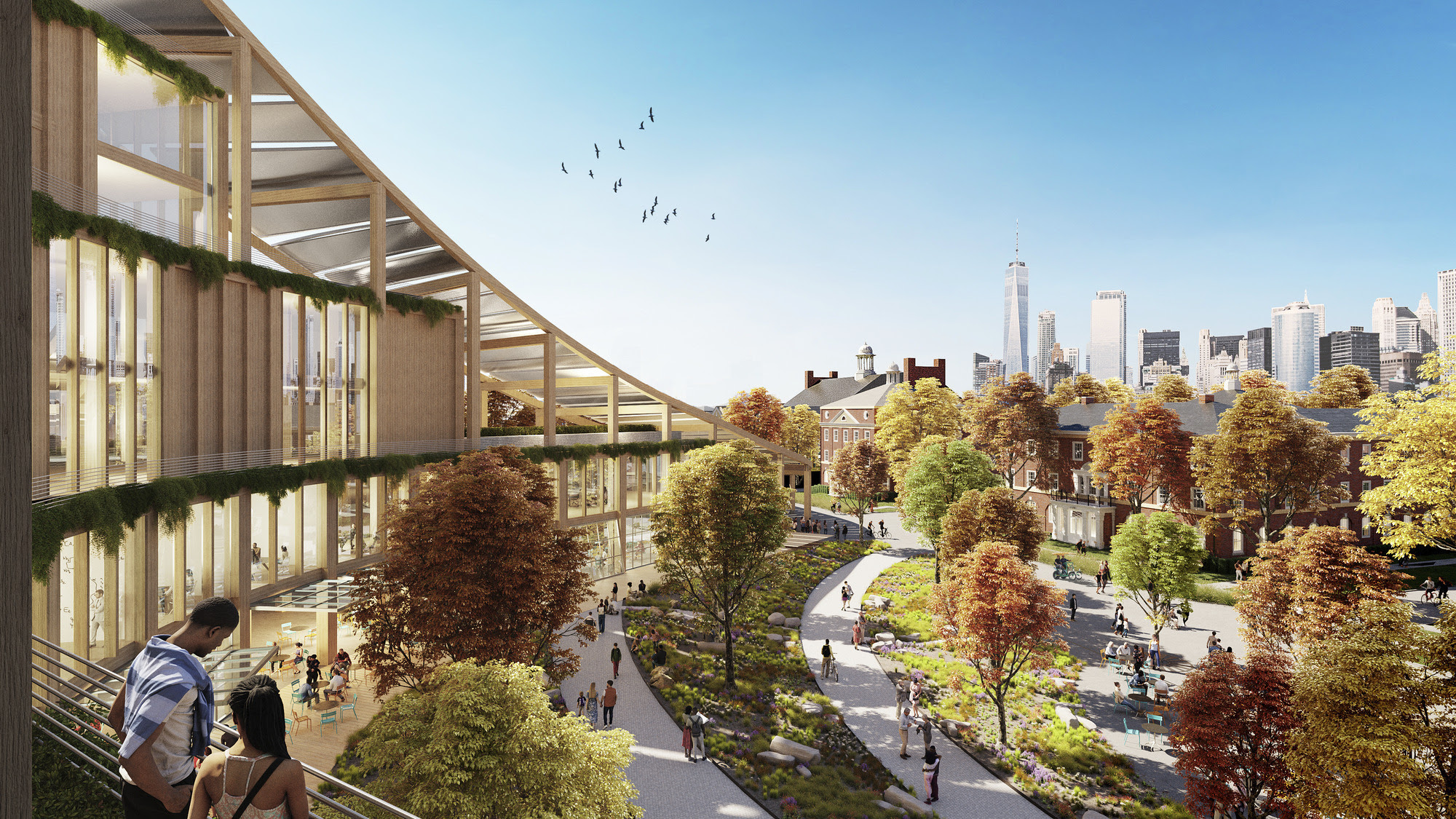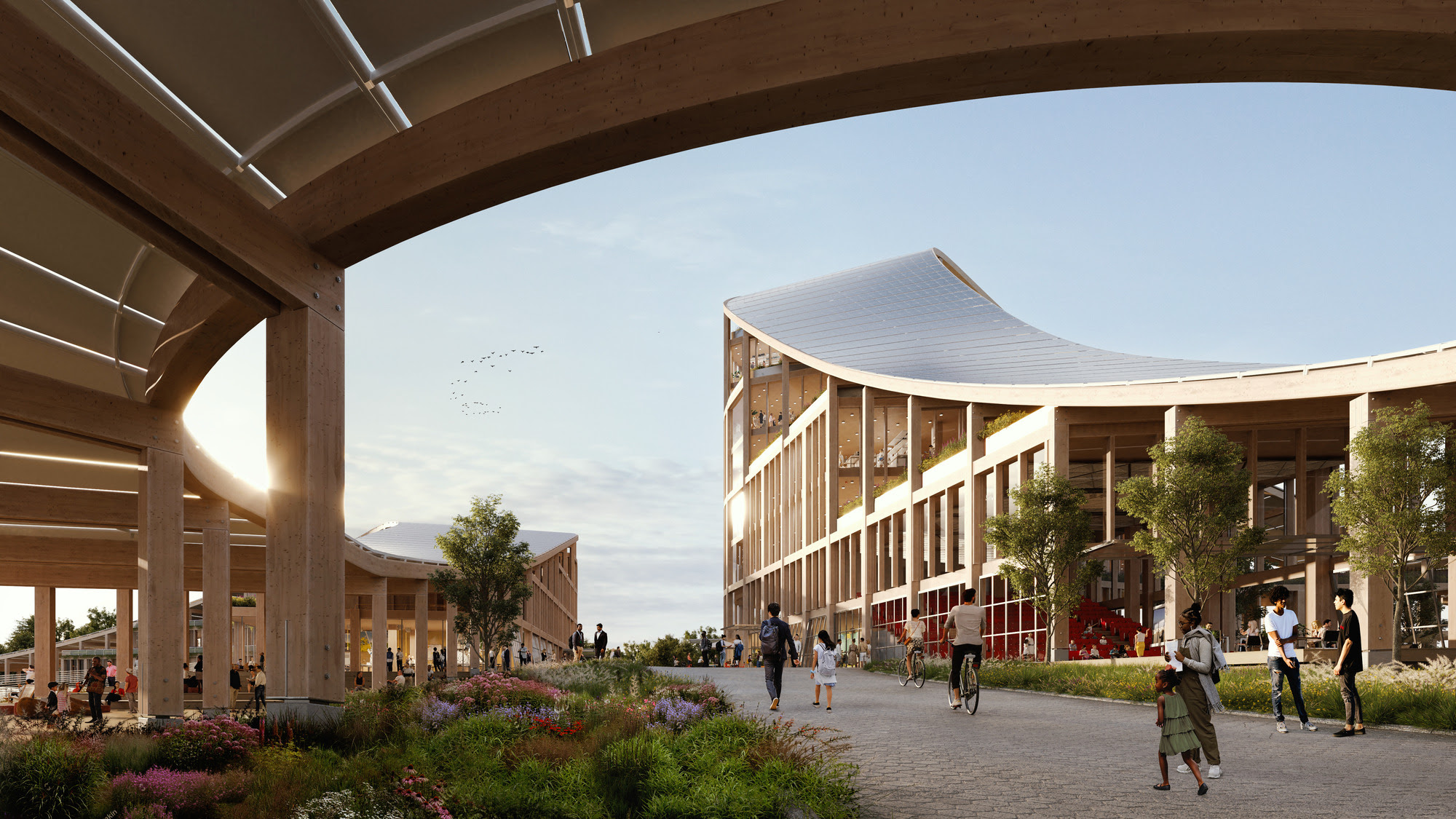Governors Island in New York Harbor will be home to a new climate-solutions center called The New York Climate Exchange. Designed by Skidmore, Owings & Merrill (SOM), The Exchange will develop and deploy solutions to the global climate crisis while also acting as a regional hub for the green economy. New York’s Stony Brook University will serve as the center’s anchor institution.
Conceived by SOM in collaboration with Mathews Nielsen Landscape Architects, Buro Happold, and Langan Engineering, the design and operations of The Exchange will deploy energy-positive design strategies such as mass timber construction, onsite solar power generation, and integration of existing buildings to achieve a net zero energy campus.
The Exchange’s 400,000-sf laboratory will feature research labs, classrooms, exhibits, greenhouses, mitigation technologies, and housing facilities. The campus’s all-electric buildings will have onsite solar electrical generation and battery storage meeting 100% of energy demand, with net positive capability to serve the local grid. All of The Exchange’s non-potable water demand will be met with rainwater or treated wastewater. And 95% of its waste will be diverted from landfills, making it one of the first U.S. sites to achieve True Zero Waste certification.
The climate-resilient design will include new buildings raised to the Design Flood Elevation of over 18 feet, with no basements. All of the campus’s new and renovated buildings will meet Living Building Challenge standards—becoming the first New York City buildings to achieve this certification.
In addition to convening global climate experts, The Exchange will host green job training and skills-building programs for local residents. The Exchange will partner with local academic institutions and other organizations on developing actionable and commercially viable solutions to the social and practical challenges created by climate change. The Exchange also will provide workforce development opportunities for communities disproportionately affected by climate change—with over 6,000 green job trainees annually once fully operational.
On the Building Team:
Client: Stony Brook University
Planning, architecture, structural engineering: Skidmore, Owings & Merrill (SOM)
Landscape architecture: Mathews Nielsen Landscape Architects
Civil/marine engineering: Langan Engineering
Sustainable infrastructure, MEP: Buro Happold
Cost estimating: AECOM



Here is the full press release from SOM:
Today on Governors Island, New York City Mayor Eric Adams and The Trust for Governors Island announced that Stony Brook University will serve as the anchor institution for the development of the new climate solutions center designed by SOM on Governors Island in New York harbor. The New York Climate Exchange (“The Exchange”) will be a first-of-its kind international center for developing and deploying dynamic solutions to our global climate crisis, while also acting as a regional hub for the rapidly evolving green economy.
“This is a place for every New Yorker to learn and engage with the environment, because all of us are in this together,” said New York City Mayor Eric Adams at the announcement.
As the lead architect on Stony Brook’s team, SOM has spent several months developing designs for a new kind of campus: one that not only sets the stage for our post-carbon world, but also centers a compelling new public realm for all New Yorkers. The design and operations of The Exchange – conceived by Skidmore, Owings & Merrill (SOM) in collaboration with Mathews Nielsen Landscape Architects, Buro Happold, and Langan Engineering – will serve as a model for sustainability, deploying energy-positive design strategies including mass timber construction, on-site solar power generation, and integration of existing buildings to achieve a net zero energy campus.
Complementing the natural landscape of Governors Island and the urban landscape of New York City, the design weaves new architecture into the island’s beloved park to create a living laboratory for research, education, and public enjoyment. The Exchange will showcase resiliency and sustainability, as the first buildings in New York City to meet Living Building Challenge standards and be one of the first sites in the country to achieve True Zero Waste certification, meet 100% of its non-potable water demand with rainwater and treated wastewater, and run entirely on electricity generated on-site—even creating enough energy to serve the city’s power grid.
In addition to convening the world’s leaders and climate experts, The Exchange will host green job training and skills-building programs for local residents to help them launch successful careers, as well as partner with local institutions like the Pratt Institute, Pace University, New York University, the City University of New York, SUNY Maritime College, Brookhaven National Labs and IBM on addressing the social and practical challenges created by climate change—including research that becomes commercially viable and ideas that lead to immediate action on the local and global levels.
"With today’s announcement, Governors Island’s role as a historic gateway to New York City enters a new chapter, as a place where ideas come to life and hopeful solutions to the climate crisis become reality,” said Trust for Governors Island President and CEO Clare Newman. “We are honored to select Stony Brook University and SOM's New York Climate Exchange to anchor the Center for Climate Solutions here on Governors Island, creating a global hub for education, research, job training, and public engagement on climate solutions for cities, set within a campus that is itself a demonstration of the future of resilient and sustainable design. Thank you to Mayor Adams, Deputy Mayor Torres-Springer, Mayor Bloomberg, and Mayor de Blasio for your commitment to the future of the Island, and thank you to President McInnis and the entire Exchange team for answering our call.”
"We are honored, excited, and proud to partner with the City of New York to build this historic center that will cement New York City as the world leader on climate change, the most pressing issue of our time,” said Stony Brook University President Maurie McInnis. “Up until now, the development of climate solutions has been siloed, with world leaders separate from expert scientists separate from the on-the-ground green workforce. As an international leader on climate and as the leading public research institution in New York, Stony Brook University will bring stakeholders together from the academic, government and business communities to make the Climate Exchange the center of research, innovation, education and collaboration to address this global crisis.”
"Our design for this new campus embodies the stewardship necessary to solve the climate crisis by weaving sinuous mass timber pavilions through the rolling landscape of the park and reusing the historic building fabric of Governors Island. Together, these spaces will cultivate advances in climate research and pilot new technologies that can be deployed across the city, and eventually the world,” said SOM Design Partner Colin Koop. “We look forward to working with the Governors Island Trust, Stony Brook University, and our team of design and engineering collaborators to bring this important project to life.”
Key elements of The New York Climate Exchange include:
- An engaging and interactive living laboratory with 400,000 square feet of green-designed building space, including research labs, classroom space, exhibits, greenhouses, mitigation technologies, and housing facilities, including:
- All-electric buildings for the entire campus with on-site solar electrical generation and battery storage meeting 100% of energy demand with net-positive capability to serve the local grid
- 100% of non-potable water demand met with rainwater or treated wastewater
- 95% of waste diverted from landfills, making this one of the first sites in the U.S. to achieve True Zero Waste certification
- Climate-resilient design including new buildings raised to the Design Flood Elevation (DFE) of +18 feet, no basements, living shorelines
- All new and renovated buildings will meet Living Building Challenge standards, and will be the first buildings in NYC to achieve this certification
- A Research and Technology Accelerator that will source and nurture ideas, projects, and new ventures dedicated to solving the climate crisis.
- Workforce development opportunities for communities disproportionately affected by climate change — with over 6,000 green job trainees annually once fully operational — ensuring New Yorkers most affected by climate change are well-positioned for new green economy jobs.
- Partnerships and collaborative grant opportunities with community-based organizations already working to mitigate the impacts of climate change.
- A Citizens Advisory Council, composed of key local stakeholders to ensure that partners’ and neighbors’ voices are heard and amplified as we jointly develop and implement new climate solutions, including those that affect low-income communities of color.
- A self-sufficient development that goes “beyond zero” toward net positive sustainability.
- Academic and community programs that prepare students at every level for careers focused on climate change solutions and environmental justice with hands-on learning, including a semester “abroad” on Governors Island, fellowship and internship programs, and continuing education.
Stony Brook, a flagship of the SUNY System, has formed international partnerships with a wide range of academic partners outside of New York City, research foundations and social justice organizations to create The New York Climate Exchange.
Related Stories
University Buildings | Oct 15, 2024
Recreation and wellness are bedfellows in new campus student centers
Student demands for amenities and services that address their emotional and mental wellbeing are impacting new development on college campuses that has led to recreation centers with wellness portfolios.
University Buildings | Oct 9, 2024
Des Moines University Medicine and Health Sciences opens a new 88-acre campus
Des Moines University Medicine and Health Sciences has opened a new campus spanning 88 acres, over three times larger than its previous location. Designed by RDG Planning & Design and built by Turner Construction, the $260 million campus features technology-rich, flexible educational spaces that promote innovative teaching methods, expand research activity, and enhance clinical services. The campus includes four buildings connected with elevated pathways and totaling 382,000 sf.
University Buildings | Oct 4, 2024
Renovations are raising higher education campuses to modern standards
AEC higher ed Giants report working on a variety of building types, from performing arts centers and libraries to business schools. Hybrid learning is seemingly here to stay. And where possible, these projects address wellness and mental health concerns.
Museums | Oct 1, 2024
UT Dallas opens Morphosis-designed Crow Museum of Asian Art
In Richardson, Tex., the University of Texas at Dallas has opened a second location for the Crow Museum of Asian Art—the first of multiple buildings that will be part of a 12-acre cultural district. When completed, the arts and performance complex, called the Edith and Peter O’Donnell Jr. Athenaeum, will include two museums, a performance hall and music building, a grand plaza, and a dedicated parking structure on the Richardson campus.
Education Facilities | Sep 16, 2024
Hot classrooms, playgrounds spur K-12 school districts to go beyond AC for cooling
With hotter weather occurring during the school year, school districts are turning to cooling strategies to complement air conditioning. Reflective playgrounds and roads, cool roofs and window films, shade structures and conversion of asphalt surfaces to a natural state are all being tried in various regions of the country.
University Buildings | Sep 4, 2024
UC San Diego’s new Multidisciplinary Life Sciences Building will support research and teaching in both health and biological sciences
The University of California San Diego has approved plans for a new Multidisciplinary Life Sciences Building, with construction starting this fall. The 200,000-sf, six-level facility will be the first building on the UC San Diego campus to bridge health science research with biological science research and teaching.
K-12 Schools | Aug 29, 2024
Designing for dyslexia: How architecture can address neurodiversity in K-12 schools
Architects play a critical role in designing school environments that support students with learning differences, particularly dyslexia, by enhancing social and emotional competence and physical comfort. Effective design principles not only benefit students with dyslexia but also improve the learning experience for all students and faculty. This article explores how key design strategies at the campus, classroom, and individual levels can foster confidence, comfort, and resilience, thereby optimizing educational outcomes for students with dyslexia and other learning differences.
Curtain Wall | Aug 15, 2024
7 steps to investigating curtain wall leaks
It is common for significant curtain wall leakage to involve multiple variables. Therefore, a comprehensive multi-faceted investigation is required to determine the origin of leakage, according to building enclosure consultants Richard Aeck and John A. Rudisill with Rimkus.
K-12 Schools | Aug 8, 2024
New K-12 STEM center hosts robotics learning, competitions in Houston suburb
A new K-12 STEM Center in a Houston suburb is the venue for robotics learning and competitions along with education about other STEM subjects. An unused storage building was transformed into a lively space for students to immerse themselves in STEM subjects. Located in Texas City, the ISD Marathon STEM and Robotics Center is the first of its kind in the district.
Education Facilities | Aug 4, 2024
A former supersonic wind tunnel becomes a new educational facility for transportation design
The Mullin Transportation Design Center at ArtCenter College of Design in Pasadena, Calif., provides access for full-scale vehicular models, replicating a professional design studio.

















